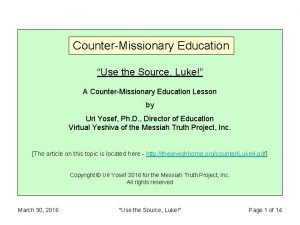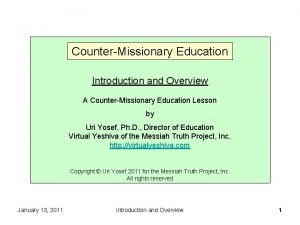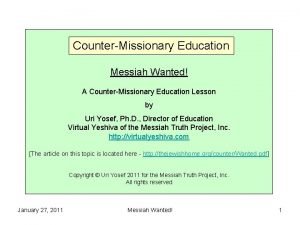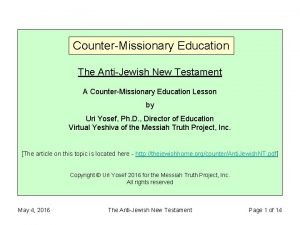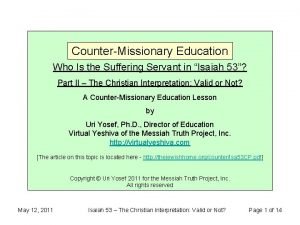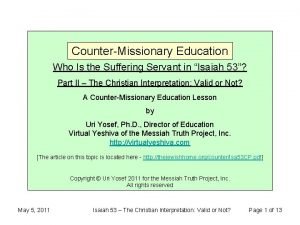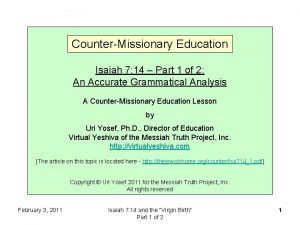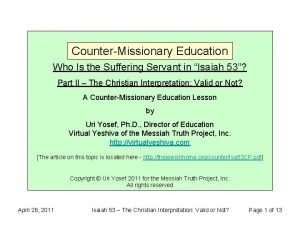CounterMissionary Education Use the Source Luke A CounterMissionary














- Slides: 14

Counter-Missionary Education “Use the Source, Luke!” A Counter-Missionary Education Lesson by Uri Yosef, Ph. D. , Director of Education Virtual Yeshiva of the Messiah Truth Project, Inc. [The article on this topic is located here - http: //thejewishhome. org/counter/Luke 4. pdf] Copyright © Uri Yosef 2016 for the Messiah Truth Project, Inc. All rights reserved March 30, 2016 "Use the Source, Luke!" Page 1 of 14

Introduction The issue of whether Jesus, Christianity's Messiah, was properly anointed in order to qualify as Messiah was addressed, and resolved, in a previous lesson titled “Proper Anointment vs. Smeared with Ointment? ”. It is, however, important to also deal with related claims, particularly when they invoke passages from the Hebrew Bible which allegedly support claims such as the one regarding the anointment of Jesus. A case-in-point is the passage Luke 4: 16 -21, of which two verses, Luke 4: 18 -19, are claimed to be quotes of Isaiah 61: 1 -2. In the original passage from the Book of Isaiah, the prophet declares that God has selected (anointed) him to prophesy about the future of Israel. The “parallel” passage in the Gospel of Luke has Jesus claiming to have fulfilled the role described by Isaiah, and Christian missionaries use this passage as evidence to support their claim that Jesus was duly anointed for his ministry as the Messiah. In this lesson we analyze the relevant texts from the New Testament and the Hebrew Bible in order to determine the validity of this claim. March 30, 2016 "Use the Source, Luke!" Page 2 of 14

The Christian Perspective The following account describes the scenario from which the claim originates (the portion allegedly quoted from the Book of Isaiah is highlighted): The author describes how Jesus went to the synagogue in Nazareth on the Sabbath, and there the “book” of Isaiah was handed to him. He opened the “book”, read a certain short passage from it, then closed it, returned the “book” to the person who gave it to him, and declared the Scripture to have been fulfilled in him. Luke 4: 16 -21 is part of a larger passage that speaks of Jesus' ministry in the Galilee, which also includes an account of his rejection in Nazareth. Christian commentators generally view Isaiah 61: 1 -2 as having been spoken by the Messiah, though some attribute these words to the "divine pre-incarnated Messiah" speaking through his prophet Isaiah. In the text, this figure gives an account of his present commission, his ministry to bring gospel mercy – his so-called "first coming", and also points to his future commission, to bring judgment on non-believers and comfort to Zion – his so-called "second coming", where the time span between the two advents is called the "acceptable year". March 30, 2016 "Use the Source, Luke!" Page 3 of 14

Analysis of the Relevant Accounts The fact that Luke 4: 18 -19 is a representation of Isaiah 61: 1 -2 is not at issue. What needs to be determined is how accurately this representation reflects the Hebrew text of Isaiah 61: 1 -2, as well as whether the context of Luke 4 is consistent with the context of Isaiah 61. Investigating the Texts The table on the next slide shows side-by-side English renditions of Luke 4: 18 -19 in the KJV New Testament, of Isaiah 61: 1 -2 in the KJV "Old Testament" and in the Hebrew Bible, and the corresponding passage from the Hebrew Bible (the Masoretic Text [MT]). The (hand-annotated) parallel passage from The Great Isaiah Scroll that was discovered in Cave 1 at Qumran is displayed at the top of the table. This portion of the text was taken from Page 49 of The Great Isaiah Scroll website (http: //www. ao. net/~fmoeller/qumdir. htm), where images of the complete Isaiah A Scroll from Qumran Cave 1 (1 QIsaª) are displayed. [Disclaimer: The Christian author of that particular web-site offers his commentary on the various displayed portions of the Scroll, commentary that is replete with errors and Christological bias. Caveat Emptor!] --- Continued on the next slide --- March 30, 2016 "Use the Source, Luke!" Page 4 of 14

Analysis of the Relevant Accounts (continued) Investigating the Texts (continued) --- Continued on the next slide --March 30, 2016 "Use the Source, Luke!" Page 5 of 14

Analysis of the Relevant Accounts (continued) Investigating the Texts - The Hebrew Texts A comparison of Isaiah 61: 1 -2 in the MT with the text from the parallel passage in The Great Isaiah Scroll reveals only one difference, where the MT has the extra word ( אדני A-do. NAI), the Lord [it should be noted that in the MT, the Tetragrammaton, יהוה , has vowel markings to have it pronounced as “elo. HIM” in this verse, a title for the Creator normally translated as “God”. The Targum Yonatan has the actual word ( אלהים E-lo. HIM) in that place]. The Hebrew word and its renditions in the other texts are highlighted in the table on the previous slide. Dead Sea Scroll (DSS) scholars have found variant manuscripts among the discoveries, two of which were scrolls of the Book of Isaiah (Isaiah A and Isaiah B), both found in Cave 1. The Isaiah A Scroll (1 QIsaa), dated by radio-carbon analysis to 335 -327 BCE and by paleographic analysis to 202 -107 BCE, is an almost completely preserved scroll, while the Isaiah B Scroll (1 QIsab), dated to the Herodian period, 30 BCE- 70 CE, contains preserved portions of Chapters 10 -66, but unlike the former, is an incomplete scroll with some chapters missing, leaving only fragmentary remains. Regarding the variations between the two Isaiah scrolls, Prof. Lawrence H. Schiffman, a prominent DSS scholar writes [Reclaiming the Dead Sea Scrolls, pp. 173 -174] - Consequently, it is not surprising that virtually all translations available today follow the MT in the opening verse, Isaiah 61: 1, with the phrase "the Lord God" that includes the “extra” phrase "the Lord" for אדני. Exceptions to this pattern are two ancient Christian translations, the LXX and Jerome's Latin Vulgate, both of which follow the Isaiah A Scroll and have "God". The Targum Yonatan, which pre-dates the Masoretic era, has "the Lord God". --- Continued on the next slide --March 30, 2016 "Use the Source, Luke!" Page 6 of 14

Analysis of the Relevant Accounts (continued) Investigating the Texts – Comparing the Texts The KJV and Jewish translations of Isaiah 61: 1 -2 are reasonably similar. On the other hand, the texts of Luke 4: 18 -19 and its alleged source, Isaiah 61: 1 -2, are considerably different and require further analysis. When these two passages are compared, it becomes evident that the author of the Gospel of Luke modified Isaiah's words as he placed them on the lips of Jesus. To help illustrate the incongruence of these passages, their two component verses are compared next. Luke 4: 18 vs. Isaiah 61: 1 The verse Luke 4: 18 is divided into the six phrases that are separated by commas and each phrase is placed in a separate row in the table. Within a given row, under each phrase from Luke 4: 18 in the KJV New Testament (NT) are placed the corresponding phrases from the KJV "Old Testament" (OT) translation of Isaiah 61: 1 and from the Jewish translation of Isaiah 61: 1 in the Hebrew Bible (HB), respectively. NT Portions that require special attention are shown in darker highlight. --- Continued on the next slide --March 30, 2016 "Use the Source, Luke!" Page 7 of 14

Analysis of the Relevant Accounts (continued) Investigating the Texts – Comparing the Texts Luke 4: 18 vs. Isaiah 61: 1 (continued) This information reveals the following significant discrepancies between Luke 4: 18 and the corresponding Isaiah 61: 1 translations (remember, according to the account in Luke 4: 1620, Jesus was reading from the "Book" of Isaiah): March 30, 2016 "Use the Source, Luke!" Page 8 of 14

Analysis of the Relevant Accounts (continued) Investigating the Texts – Comparing the Texts Luke 4: 19 vs. Isaiah 61: 2 The verse Luke 4: 19 (NT) is shown in table below, with the corresponding portions from the KJV "Old Testament" (OT) translation of Isaiah 61: 2 and the Jewish translation of Isaiah 61: 2 in the Hebrew Bible (HB) placed below it. The highlighted NT portion requires special attention. This information reveals the following significant discrepancy between Luke 4: 19 and the corresponding Isaiah 61: 2 translations [remember, according to the context of Luke 4: 16 -20, Jesus was reading from Isaiah]: March 30, 2016 "Use the Source, Luke!" Page 9 of 14

Analysis of the Relevant Accounts (continued) Another passage from the same chapter in the Gospel of Luke, Chapter 4, gives even more reason to question the credibility of Luke 4: 18 -19. . Following the statements by Jesus about his ministry and the fulfillment of Scripture through his presence at this synagogue in Nazareth, he declares that the congregants were unworthy to see him perform miracles. According to the account, these statements enraged the crowd to such a degree that they wanted to kill him: The highlighted portion describes the geographical terrain near the city limits of Nazareth. There is, however, a problem with that particular description, since Nazareth is situated on a plain that is surrounded by the rolling hills of the Galilee. Though the Nazareth of today has expanded to the tops of the hills that surround it, in former times it was situated in the lower part, on the slope of a hill, and was surrounded by gentle rises. The entire region is noted for its plains and smoothly contoured land elevation, and there are no sharp peaks or steep cliffs nearby. Therefore, contrary to the description in Luke 4: 29, there is neither any “ ” nor any steep cliff from which “ ” in the immediate vicinity of the city Nazareth, particularly around the area of the city that is considered by Christian tradition to be the village of Joseph, Mary, and Jesus. It is also worth noting that archaeological remains of a synagogue from the Second Temple period have not been found in the intensely explored area in and around Nazareth. On the other hand, archaeological remnants of such a synagogue were discovered in the village of Gamla, which is located on the top of a hill overlooking the eastern shore of the Sea of Galilee, which also has dangerous cliffs close by. This is the western edge of the region known today as the Golan Heights. Could it be that the author of the Gospel of Luke changed the geographical description to suit the story in his narrative? March 30, 2016 "Use the Source, Luke!" Page 10 of 14

Analysis of the Relevant Accounts (continued) Comparing Context As was noted earlier, Christians attribute the words in Isaiah 61: 1 -2, thus also Luke 4: 18 -19, to the Messiah, or the "pre-incarnated Messiah" (God, according to them) speaking through his prophet Isaiah, where he describes the mission of his ministry. This is inconsistent with the Jewish perspective on Isaiah 61: 1 -2. There are, of course, no specific clues in Isaiah 61: 1 -2 to positively identify Jesus as the speaker. According to the immediate context in the Hebrew Bible, it is the prophet, not the promised Messiah, who is speaking in Isaiah 61: 1 -2. Isaiah speaks of himself and the nature of his mission, as an appointed messenger of God. The term ( משח ma. SHAḤ), commonly translated as [he] has anointed , is to be understood in the context of [he] has appointed or [he] has chosen, since only kings and high priests of Israel, but not prophets, were anointed via the special process described in the Hebrew Bible (see the lesson Proper Anointment vs. Smearing with Ointment for details). As was the case with all true prophets of Israel, who set the standard for the entire community as role models of holiness, scholarship, and closeness to God, the Divine Presence ( שכינה [sh’chi. NAH]) came to rest upon Isaiah and endowed him with the gift of prophecy as he reached this level of spiritual and ethical achievement. Here Isaiah is a herald of joy, telling his people that God will yet free them from their captivity and exile. The spirit he is talking of is the spirit of prophecy. Through this gift Isaiah was able to convey to the people of Israel the divine message of promise that is developed throughout this and the following chapter, a vivid picture of Israel and Jerusalem in the messianic era. --- Continued on the next slide --- March 30, 2016 "Use the Source, Luke!" Page 11 of 14

Analysis of the Relevant Accounts (continued) Comparing Context (continued) By placing Isaiah's words in the mouth of Jesus, the author of the Gospel of Luke actually has Jesus admitting, contrary to mainline Christian beliefs, that he is, at best, only a prophet and not God. Moreover, the New Testament offers no evidence that Jesus fulfilled the actions described in Isaiah 61: 1 -2. Did he free any captives or prisoners? Against whom did he come in vengeance? March 30, 2016 "Use the Source, Luke!" Page 12 of 14

Analysis of the Relevant Accounts (continued) Christian missionary counter argument and the Jewish response The textual differences between Luke 4: 18 -19 and Isaiah 61: 1 -2 cannot be denied and, therefore, the options available to Christian missionaries are rather limited, leaving one common argument visà-vis the irrefutable evidence. Christians acknowledge and accept the doctrine of the divinity of Jesus. As God, they claim he had the right and the authority to paraphrase, in any way that suited him, Isaiah’s inspired words. The Hebrew Bible does not support the Christian belief that Jesus is a son that God fathered, who was "God in the flesh" on earth, and who, as part of the triune godhead, was divine. Moreover, to suggest that God can and will do as he pleases and even violate the rules and laws He gave to Israel, would be analogous to parents, as role models, teaching their children to "do as I say but not as I do". The Hebrew Bible is replete with examples in which Israel is asked to emulate and follow God’s ways. Are they to also follow the example where God violates his own rules? What sense would it then make to have faith, and what would be the point of having the Bible? Finally, it is ludicrous to suggest that God had to appoint (“anoint”) Himself to carry out a mission. The Christian view of Psalms 22: 1, according to which Jesus complains to God about having been forsaken by him, is another example of such incongruous logic. March 30, 2016 "Use the Source, Luke!" Page 13 of 14

Summary According to the New Testament and, thus, the Christian perspective, Jesus quotes Isaiah 61: 1 -2 in Luke 4: 18 -19, modulo some changes he made to the source, which he, being "God incarnate", was entitled to do, as he was reading from it. When he was done, he told the crowd that these Scriptures were fulfilled in him at that time. Christian missionaries defend their doctrines by claiming that the advent of Jesus and of the New Testament are elements of a new revelation, one that the Jews who lived prior to the Christian era did not receive. Can this be true? Were doctrines of such importance hidden from the Jewish people for some 1, 300 years after the Revelation at Mount Sinai? Were all the Jews who lived before the time of Jesus deceived or tricked? As DSS research has demonstrated, the text of the Hebrew Bible did not change in any significant manner from the period of the Qumran texts to the time of preparation of the Masoretic Text that is in use today, a span of well over 1, 000 years. A Jew who read Isaiah 61 before the birth of Jesus still read essentially the same text as a Jew who reads it today and, clearly, the message remains unchanged as well. No, there were no secret revelations planned and, according to the prophets, Israel received all that was to be revealed, and this cannot be stated in any clearer way than in the Hebrew Bible itself: March 30, 2016 "Use the Source, Luke!" Page 14 of 14
 Use the source luke
Use the source luke Hát kết hợp bộ gõ cơ thể
Hát kết hợp bộ gõ cơ thể Frameset trong html5
Frameset trong html5 Bổ thể
Bổ thể Tỉ lệ cơ thể trẻ em
Tỉ lệ cơ thể trẻ em Chó sói
Chó sói Tư thế worms-breton
Tư thế worms-breton Hát lên người ơi
Hát lên người ơi Môn thể thao bắt đầu bằng chữ f
Môn thể thao bắt đầu bằng chữ f Thế nào là hệ số cao nhất
Thế nào là hệ số cao nhất Các châu lục và đại dương trên thế giới
Các châu lục và đại dương trên thế giới Công thức tính thế năng
Công thức tính thế năng Trời xanh đây là của chúng ta thể thơ
Trời xanh đây là của chúng ta thể thơ Mật thư anh em như thể tay chân
Mật thư anh em như thể tay chân Phép trừ bù
Phép trừ bù
